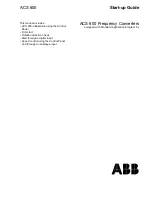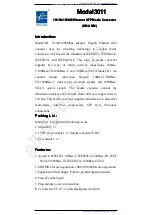
PAQ
65D
PAQ
B-256
・All specifications are subject to change without notice.
Storage Ambient Temperature
Abrupt temperature change would cause condensation
built-up that leads to poor solderability of terminals of the
power module.
Storage Ambient Humidity
High temperature and humidity can cause the terminals on
the module to oxidize. The quality of the solder will become
worse.
Cooling Method
Forced air cooling is recommended. Convection cooling is
also possible. For the details of derating, refer to “Mounting
Method and Thermal condition”.
Ambient Temperature vs. Output Voltage Drift
Temperature coefficient is defined as the rate of voltage
change when ambient temperature is changed during opera-
tion.
Withstand Voltage
This power module is designed to have a withstand volt-
age of 1.5kVDC between input to output. When conduct-
ing withstand voltage test during incoming inspection, be
sure to apply DC voltage. Also, set the current limit value
of the withstand voltage testing equipment to 10mA. Be
sure to avoid conducting test with AC voltage because this
would cause power module damage. Furthermore, avoid
throw in or shut off of the testing equipment when applying
or when shutting down the test voltage. Instead, gradually
increase or decrease the applied voltage. Take note espe-
cially not to use the timer of the test equipment because
when the timer switches the applied voltage off, impulse
voltage which has several times the magnitude of the ap-
plied voltage is generated causing damage to the power
module.
For testing, short all the input side together and output
side together as shown in the diagram below.
Vo1
TRM1
GND
TRM2
Vo2
+
Vin
−
Vin
CNT
WITHSTAND
VOLTAGE TESTER
Test condition: 1.5kVDC 1minute (10mA)
Fig.17-1: Withstand Voltage Test for Input-Output
Insulation Resistance
Use DC insulation tester (MAX 500V) between output
and input. Insulation resistance value is 100Mohm and
above at 500VDC applied voltage.
Make sure that during testing, the isolation testers does
not produce a high pulse when the applied voltage is var-
ied. Ensure that the tester is fully discharged after the test.
Vo1
TRM1
GND
TRM2
Vo2
+
Vin
−
Vin
CNT
ISOLATION
TESTER
Fig.18-1: Isolation test
Vibration
Vibration of power module is defined in case of mounting
on PCB.
Shock
Value for the conditions of out shipping and packaging.
3. Mounting Method and Thermal Condition
1 Output derating
There is no restriction on mounting direction but there should
be enough consideration for airflow so that heat does not
accumulate around the power module vicinity. Determine
external components configuration and mounting direction on
PCB such that air flow through power module from forced air
or convection cooling is not blocked. Take note, output power
derating is needed as shown in followings. (Refer to output
derating by ambient temperature.)
For actual application with difficulty of air flow measurement,
it is recommended to measure MOSFET Q15 temperature
in order to ensure the power module operates within derating
curve. (Refer to output derating by MOSFET Q15 tempera-
ture).
The output derating by ambient temperature curves provided
is based on the below set-up condition. It is therefore advis-
able to do actual thermal measurement on MOSFET Q15
before confirming the thermal design.
C
L
AIRFLOW
AIRFLOW
INPUT
OUTPUT
25.4mm
PCB
PCB
12.7mm
76mm
POWER
MODULE
POWER
MODULE
Ta AND AIR
VELOCITY
MEASEUREMENT
POINT
TOP VIEW
Fig.1-1: Mounting method
Содержание PAQ50S48-1R2
Страница 36: ...B 260...





































